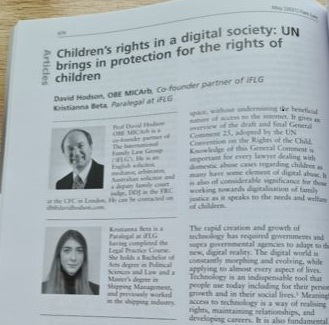The rapid growth of technology has led societies to adapt to the circumstances that a new, digital reality, as some would describe it, has been created. The digital world is constantly morphing and evolving, while applying to almost every aspect of our lives. Technology is an indispensable tool that people use today, among other things, for their personal growth and in their social lives. Meaningful access to technology is a way of realising our rights, maintaining our relationships, and developing our careers.
Technology also plays an essential role to the formation and development of childhood and adolescence. From education and training to the maintenance of friendships, children now represent one third of online users. Children now have better access to technological resources than ever before. Engagement in an increasingly digitalised reality necessitates not only a rational understanding and appreciation of its benefits, but also a greater degree of protection, especially towards children. This begs the question; how can we ensure protection against the violation of children’s rights in a digitalised society?
Human rights apply profoundly to both the physical and the digital world — rights of all and especially children should be protected and treated with utmost respect. The risks and hazards are imminent and should be approached to prevent harm.
David Hodson OBE drew attention to this in his article ‘Digital Domestic Abuse: The need for International Laws and Protections’ in which he highlights the need for cross border protection from digital domestic abuse. As ‘the wheels of international legislation turn very slowly’, a greater commitment is required from international organisations, to put measures in place, in order to combat digital abuse and the violation of one’s rights.
In response to the exigency of protection against digital abuse, in February 2021 the UN Committee on the Rights of the Child has adopted General Comment 25 on the children’s rights in relation to the digital environment.
This authoritative document, which puts children’s rights and safety at the forefront of our societies, aims to become applicable to all interested states, regardless of their political social allegiances, traditions and to all children, notwithstanding their current circumstances. Due to the sensitivity of the issue, the draft has been thoroughly and meticulously constructed considering children’s rights. It recognises the significant role of technology in children’s lives and invites Member States to adopt and implement measures in order to mitigate the risk of harm. It offers guidelines to ensure compliance with the obligations under the Convention, acknowledging the advantages as well as the challenges of children’s rights in the digital world.
Whilst offering an insight of the principles acting as directions to how children’s rights should be approached by Member States, the draft General Comment 25 requires the interested parties to adopt legislative measures, develop their policies, strategies, and remedial mechanisms to combat violations, in order to ensure that the digital environment abides by the rights under the Convention. More importantly, the draft stretches, even extends, the importance of children’s civil rights and freedoms, such Articles 13 & 17, which relate to access to information. In respect to Article 12 of the Convention, which refers to the right of children to express their views in matters that affect them, the drafting team initiated a consultation with children, in an effort to combine their views on the matter with the General Comment 25.
In August 2020, the Committee invited all interested parties to comment on the preliminary draft of the General Comment. Each party submitted their views and comments. Reference should be made to the UK’s submission as well as the comments from the Council of Europe.
In terms of the submissions made by the UK, the Government recognised the importance of the Committee’s draft. The comments of the Government evolved around some points where the draft was considered to be incompatible with the UK’s perception of International Law. In general, the UK requested minor changes, focusing on the rephrasing, and rewording of some paragraphs in order to become more aligned with the Articles of the Convention. Importantly, with reference to Article 8, the rights of a child to preserve their identity, the UK proposed the inclusion of a sentence covering the protection of children from persecution, by either digital or any other means, arising from the child’s identity.
Equal emphasis should be placed on the comments submitted by the Secretariat of the Council of Europe. The Council offers a substantial number of directions and guidance towards combating digital violence. Most of the Council’s comments were concentrated around the responsibilities of enterprises and data protection, while fostering national co-operation between key partners. In addition, States were invited to take into consideration the guidelines offered by the Council, which set a solid background for aiding states in their effort to safeguard children’s best interests in a digital world. Also, the Council encourages accession by non-CEO Member States to the Lanzarote Convention, which sets benchmarks on criminal laws to protect children from violence.
Considering all the above, the Draft General Comment underlines the benefits and possibilities of what progress technology offers, whilst acknowledging its risk and challenges. Its guidelines encompass a solid ground for the protection and fulfilment worldwide of the rights of children. In essence, it creates an unequivocal obligation on the part of the interested states, to abide by the directions outlined by the Committee on the Rights of the Child. The General Comment, which for the first time advocates the rights of children in the digital world, received approval on the 3 February 2021. The ongoing need to address abuse of the rights of children in a digital reality will receive real-world flesh and bones, creating the base ground for human rights to apply to both the physical and the digital world. One must not forget however, that organisations and states should continue this work and encourage the adoption of new measures in order to combat digital violence. What remains to be seen is the final document which The International Family Law Group LLP, as a leading firm on such matters, will publish as soon as it becomes available.
If you would like more information or to discuss rights and protection of children in the digital environment, please contact the authors at iFLG.
David Hodson OBE KC(Hons) MCIArb
[email protected]
The International Family Law Group LLP
www.iflg.uk.com
© February 2021
-
Prof David Hodson OBE KC(Hons) MCIArbhttps://iflg.uk.com/team/prof-david-hodson-obe-kchons-mciarb
-
Prof David Hodson OBE KC(Hons) MCIArbhttps://iflg.uk.com/team/prof-david-hodson-obe-kchons-mciarb
-
Prof David Hodson OBE KC(Hons) MCIArbhttps://iflg.uk.com/team/prof-david-hodson-obe-kchons-mciarb
-
Prof David Hodson OBE KC(Hons) MCIArbhttps://iflg.uk.com/team/prof-david-hodson-obe-kchons-mciarb









